Site Menu:
| This is an archived Horseadvice.com Discussion. The parent article and menus are available on the navigation menu below: |
| HorseAdvice.com » Horse Care » Routine Horse Care » Hair Coat Care » |
| Discussion on Coat color and mane | |
| Author | Message |
| Member: Mientjie |
Posted on Monday, Jun 12, 2006 - 1:50 pm: Hi everyoneI'm just curious about my mare's coat color. She changes all the time. I have had her for 11 months now. In the summer she was a bay dun (she has a dorsal stripe and the dun characteristics) and now (its winter here) she seems to be almost like a red bay. If you brush up the hair it is a light cream color underneath. Do you think she'll be that color in summer or bay dun again? Her mane is growing now and is VERY thick. Do you think she'll look nice with a long mane? Here is the link to her personal album  : : https://s36.photobucket.com/albums/e16/mientjie/Amanda/ We still have to put up the new photos. All your thought and comments will be appreciated! Lea-Anne |
| Member: Qh4me |
Posted on Monday, Jun 12, 2006 - 2:03 pm: Hi Lea-Anne,I don't have many comments on the colour, but just wanted to say what a nice mare! And I love the barn! |
| Member: Mrose |
Posted on Monday, Jun 12, 2006 - 3:13 pm: Just based on her looks, I'd call her a bay. I've seen a lot of bays that have a darker stripe across their shoulders, but at least with Arabians, they are considered bays. It's common for the bays to get darker in the winter and lighter and more red in the summer. I'd be very surprised if she turned cream.She's a very pretty mare. I think she's look great with a long mane and tail, but that's just my opinion. Whether you let it grow might depend on any breed requirements if you plan on showing her. |
| Member: Maggienm |
Posted on Monday, Jun 12, 2006 - 5:02 pm: Lea-AnneI know sometimes the detail we can see with our eye doesn't come through on the camera, but I don't see any leg baring or dorsal stripe associated with dun. In one pic I saw what might be a bit of shading not to be confused with a stripe, on the shoulder. Your winter looks pretty mild compared to mine. She is a very lovely bay. Her eye seems soft and her expression kind and willing. I wish you many happy years with her. |
| Member: Ilona |
Posted on Monday, Jun 12, 2006 - 6:30 pm: Hi Lea Anne,Looking at your photo's roused in me a great longing for South Africa. Has your mare grown since your last posting? She looks lovely, and has a beautiful, gentle face/demeanor. Where are the stables in your pictures? I took instruction from Bill Johnson in Bryanston way before your time and was often the pre-adolescent decoy for his affair with Mary Oppenheimer. They were supposedly taking me in instructive trail rides!! They did later marry, but it was quite the scandal at the time. Regarding color, IMO she is a delicious bay. |
| Member: Mientjie |
Posted on Tuesday, Jun 13, 2006 - 5:03 am: Thanks everyone! Her color doesn't show clearly on the photos but in summer her coat was almost a deep gold color. She does't have markings on her shoulders but has a dark dorsal stripe on her back.Ilona I think she has grown a little bit but I'm not sure. Amanda is stabled at Mooikloof Equestrain Center in Pretoria East (its close to the Pretoria East hospital). The stables are lovely but are a little small for my big girl! Lori our winter this year is very cold compared to last year. All the horses have nice wooly coats now. Amanda is very kind and willing but can be stubborn when she wants to be. She is amazing and is now a happy and active horse now that she is on her special diet for EPSM. |
| Member: mientjie |
Posted on Tuesday, Apr 10, 2007 - 3:20 am: Well Amanda's color changed again, I can't keep up! LOL. She is much darker than she used to be, what would you call the color she is now? https://s36.photobucket.com/albums/e16/mientjie/Amanda/?action=view¤t=IMG_8 126.jpghttps://s36.photobucket.com/albums/e16/mientjie/Amanda/?action=view¤t=IMG_1 043.jpg Our other photos: https://s36.photobucket.com/albums/e16/mientjie/? |
| Member: canter |
Posted on Tuesday, Apr 10, 2007 - 7:50 am: She looks like a lovely shiny bay to me, Lea-Anne. From the pix, her mane and tale look black, is that correct?If I could "make" my perfect horse, the coloring would be very much like Amandas: medium bay with black points on legs and tips of ears. |
| Member: 36541 |
Posted on Tuesday, Apr 10, 2007 - 8:04 am: My personal favorite as well - mahagony bay with chrome! I seem to always breed black bays with zero chrome. Its hard to see my herd at night as three of the five are a complete blend with the dark. I think your mare is a stunner!! |
| Member: dres |
Posted on Tuesday, Apr 10, 2007 - 9:48 am: a lovely bay... Does she get redder in the summer..?On the first day God created horses, on the second day he painted them with spots.. |
| Member: mitma |
Posted on Tuesday, Apr 10, 2007 - 11:04 am: Lea-Anne,She is a gorgeous mare!!! But, I agree with everyone else... I don't think she carries the dun factor. Some "non-dun" horses can manifest a "faux" dorsal stripe, I think it's seen more in bays, rather than chestnuts, but, I'm not absolutely sure... Last year, I read the book, "Equine Color Genetics" by D. Phillip Sponenberg. Dr. Sponenberg is a professor at the Virginia-Maryland Regional College of Veterinary Medicine in Blacksburg, Virginia and does extensive research on this topic. You might want to pick up a copy of the book (amazon.com or some other site). Also, there are a few people on this site who have discussed a great deal about horse color genetics... you might want to do a search for these topics on old threads as I can't remember who was involved in those previous threads at this point in time. Good Luck with your beautiful mare. Martha |
| Member: alden |
Posted on Tuesday, Apr 10, 2007 - 8:17 pm: You have a very good looking Bay mare there, Bays are a personal favorite of mine. We have two but they have no white at all.We have 2 Sorrels, 2 Greys, 2 Bays, 1 Dun , 1 Paint and 1 spotted donkey. And they all change color with the seasons except the Paint (Dun Tobiano) Stallion and the donkey. They get woolly and have lots of hair in the winter but stay the same colors. Dun is often used to describe color and that isn't completely correct, it has more to do with genetics. Take our paint stallion, he's papers say "Dun/Tobiano" for color. It would be more correct to say Sorrel/Tobiano or Red/Tobiano because he has no Dun markings and isn't a Dun in any way. Pictures @ https://www.rockinaceranch.com/stallions.html It does make things confusing at times. Good day Alden |
| Member: amara |
Posted on Tuesday, Apr 10, 2007 - 8:51 pm: her color is much the same as my little arab, complete with "faux" dorsal stripe... only he has a whole lot more chrome...she sure is pretty!! |
| Member: muffi |
Posted on Tuesday, Apr 10, 2007 - 10:07 pm: Ok I have a color question - I have a Golden Chestnut TWH/QH mix. he has sort of a flaxen main and tail - his Sire was a black and white paint TWH and his Dam was a chestnut QH. He got his color from his Dam. Now he appears to be getting lite colored hair mixed in his red. does any one know of Chestnuts (ok Sorrels) that go to Roany ish colors as they age - ? He is 8.I'll try and get some pictures tomorrow in the sun to show you - Oh and he has a Brown spot on his right rear. looks a lot like dirt but it's not. |
| Member: hunysgrl |
Posted on Tuesday, Apr 10, 2007 - 11:57 pm: I once had a sorrel QH mare who the vet considered to be a roan because she had several white hairs mixed in with her sorrel coat. The amount of hairs progressed with her age during the 5 years that I had her. She had four white stockings and was a light colored sorrel. She too had the brown spots (two) on her left rear hindquarter, directly above her leg. They didn't show much during the winter, but when she shed her winter hair, they really showed and were quite dark. |
| Member: mientjie |
Posted on Wednesday, Apr 11, 2007 - 12:53 am: Thanks! She is lovely. She is definitely a bay but what kind? Red Bay, mahagony bay?She does get lighter in summer almost a golden redish color. A long mane looked terrible on her so we had to pull it for shows and it looks great! |
| Member: tuckern |
Posted on Wednesday, Apr 11, 2007 - 8:47 am: Muffi, my mare is a sorrel who is roaning out as she gets older. I've had her for three years now, and each year, she gets a few more white hairs. It is especially noticeable on her face. She has a wide blaze, and where the edges of the blaze used to be sharp, it is now fading as she gets more white hairs. Makes her look older than she really is! (she's 11 this year). I tease her and tell her she's going to be solid white by the time she's 20, lol. She also has a dark spot on her left rump. It's about the size of a silver-dollar.Lea-Anne, your mare is gorgeous! I especially like the dapples that's visible in some of the pictures. =) Nicole |
| Member: dres |
Posted on Wednesday, Apr 11, 2007 - 10:14 am: I was thinking on the lines of a blood bay, thus my question above..On the first day God created horses, on the second day he painted them with spots. |
| Member: alden |
Posted on Wednesday, Apr 11, 2007 - 7:16 pm: For those Sorrels that are turning white look for Grey parentage. One of my Grey horses was very sorrel his first year, over the years he's turned white. Now at 13 all the red is gone and almost all the Grey and he looks white.I also have a younger mare, nine now, with the same Sire (the sire is the Grey parent) as the 13 yro, she's also been getting white hairs but much more slowly than her older half brother. Then there is one that was a great Buckskin color as a two yro, but he's got the Grey gene/curse (depending on your view point) and is no longer Buckskin but almost white in areas. Good day, Alden |
| Member: muffi |
Posted on Thursday, Apr 12, 2007 - 12:31 am: I went out today and took pictures - they don't show really well but I have the Brown Butt spot -= Amanda and Nicole - A little bigger than a silver dollar - I would say Football sized (LOL)first shot is how he is Whiting out - this is on his face but its the same all over and this is his overall shot and his brown spot so guys you think he will go roany? all I know about are his parents neither was a grey. 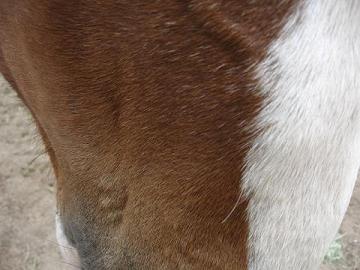 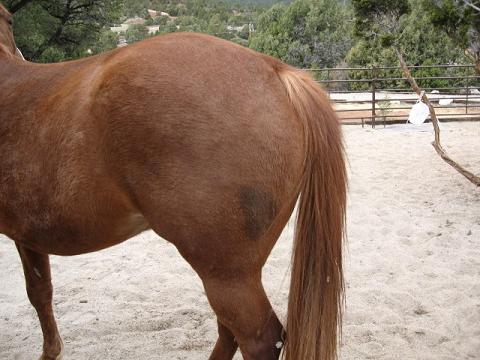 you also have to have the full view - 
|
| Member: mitma |
Posted on Thursday, Apr 12, 2007 - 11:33 pm: Lea-Anne,I think your lovely mare is a bay with medium shading, i.e., a red bay. Initially, I thought, like many others who have commented, that she was a blood bay or mahogany bay (bay with dark shading), but I've looked at most of your pictures now and there are some which appear to show a bit of "gold" tone in addition to her obvious redness. Either way, she is so beautiful and isn't she a draft cross??? Her head profile has a bit of the Clydesdale look to it.... Just lovely! Muffi, I think that the "brown butt" spot on your horse is called a Bend Or (or Ben d'Or) spot... they are typically just random areas of darkness found on chestnut horses... maybe, similar to birthmarks in humans??? And, btw, the white hairs could be very minimal roaning, but the roan gene (Rn), like the gene that controls for the grey color, is a dominant one, so one parent would have absolutely manifested the roan appearance... what do you know of your horse's parents??? Lea-Anne (again), I have two horses that demonstrate the dun gene (Dn); they are both grullos (grullo in males, grulla in females) which is a manifestation of the dun gene on a black base coat... When we call a horse a dun (and it is the result of the dun gene) that implies that the base coat of the horse is a chestnut. I just LUV the dun gene in horses!!! My 4 yo gelding (who happens to be a registered Appaloosa though he is solid and does not have any spots!!!) shows the characteristic dorsal stripe and leg barring seen with the dun gene. You may also see that his coat color appears very light (I think he is a light grullo) and I have wondered if this means that he also has another "dilution" gene, the cream gene (Cr) (which is what produces a palomino from a chestnut)!! The other two dilution genes are the champagne (Ch) and silver dapple (Z) genes... to me, that's when the dilution thing gets very complicated!! Enjoy the pictures below... the other horse pictured with him is his pasture mate, a 2 yo black/white tobiano draft cross gelding. And the last picture is my 10 yo Quarterhorse/Percheron cross mare, who is the more usual shade of grulla, though I think she has a bit of shade or sooty effect... Martha 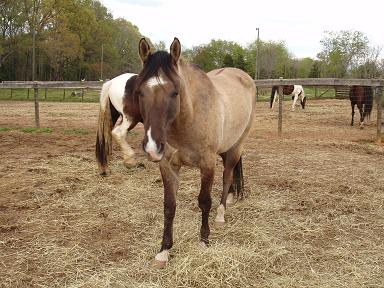 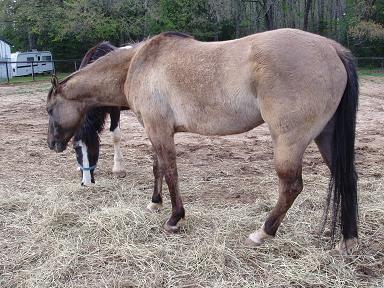 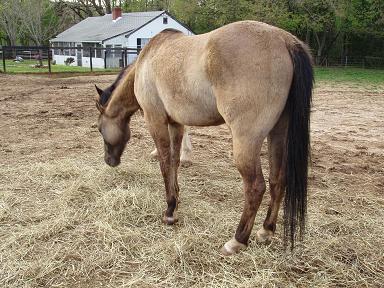 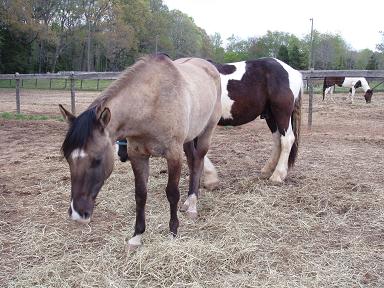  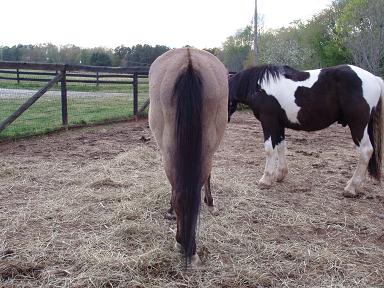 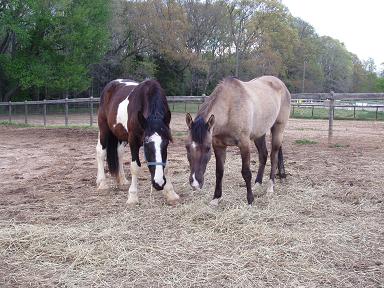 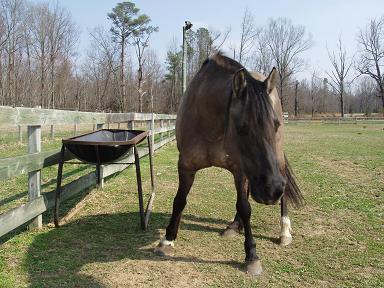 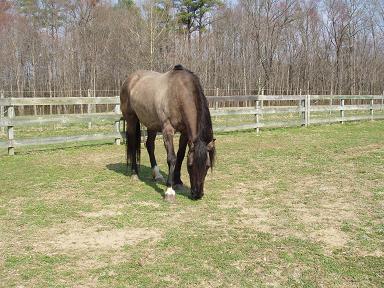
|
| Member: canter |
Posted on Friday, Apr 13, 2007 - 8:23 am: My first horse, a chestnut, also had a dark spot on his butt. When I first bought him (I was brand new to horses), I thought it was some ground in dirt and practically rubbed the poor guy raw trying to scrub it off. Good thing he was so good natured or I probably would have ended up kicked through a wall! |
| Member: juliem |
Posted on Friday, Apr 13, 2007 - 12:03 pm: Martha, what color would you call this filly? She has a dorsal stripe, leg barring, whither and neck bars.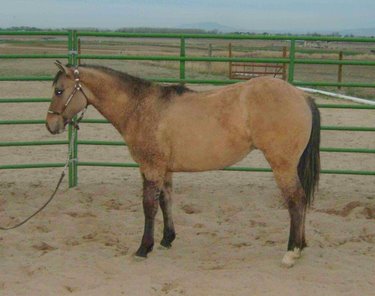
|
| Member: mitma |
Posted on Friday, Apr 13, 2007 - 12:52 pm: Hey Julie,She's quite cute... is she your's???? From the picture, she clearly seems to have the dun gene and possibly the cream gene, so she's either a light or golden grulla or a bay/buckskin dun (aka a dunskin)... she really does seem to have a "golden glow" to her, so I would vote for her being a dunskin (a bay base coat with the cream dilution gene that turns the horse into a buckskin, then add the dun gene and the horse becomes a dunskin, with all the primitive markings, etc...) There is the possibility that she has one of those other more complicated dilution genes, the champagne or the silver dapple genes and then we need to know what color are her skin and her eyes??? Her conformation suggests to me that she's a Quarter Horse and I think the champagne gene is rare in QHs. However, there is someone on HA.com who breeds QHs with the champagne gene... I just can't remember who that is... A few months ago, there was a thread that discussed the champagne dilution gene... Try to look it up! For another example of a nice dunskin, check out the Spanish Mustang Registry website (www.spanishmustang.org) and look up "stallions" and look at VA for a guy named Cayuse Gold. He stands at a farm in Suffolk, VA called ?Rainbows End Farm. I've never seen him in person, but his pictures are nice! Good Luck! Martha |
| Member: lhenning |
Posted on Friday, Apr 13, 2007 - 1:15 pm: Hey Martha,I've been told the light coloring on my sorrel is a "birthmark". Do you know if this Bend Or/ Ben D'Or spot can be light colored as well? My horse has a large light colored marking down his shoulder that has been there all his life. Thanks, Linda 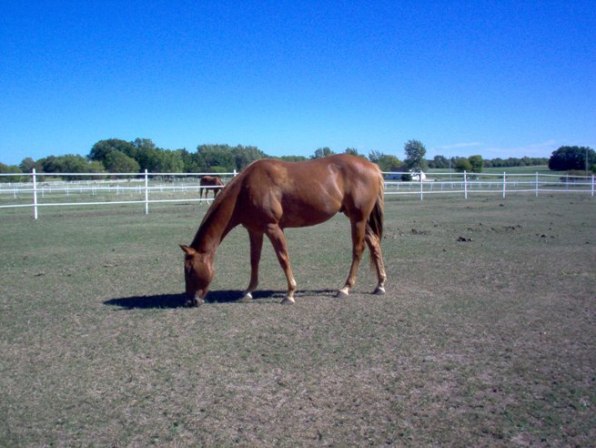
|
| Member: juliem |
Posted on Friday, Apr 13, 2007 - 1:53 pm: Thanks Martha--she is a quarter horse. I bought her a two weeks ago as a project--she's only been halter broken. I was told her mother is a grulla. I will spend a year working with her on the ground and have her for sale next spring. She has already changed from this picture taken in March--she's more the typical buckskin color now. I'll post a picture when she finishes shedding out as I'd like your opinion. Probably should have started another thread. Ooops! |
| Member: mitma |
Posted on Friday, Apr 13, 2007 - 2:13 pm: Linda,I always thought that Ben d'Or spots were dark, but I could be wrong... I'll try to look up the answer... I have been told, however, that "birthmarks" do occur in horses. Julie, Do you know what color her sire was??? If her dam was a grulla, then that's where she got the dun gene from (unless, her sire was a dun also). Perhaps, her sire contributed a cream gene??? I would love to see what she looks like when she sheds out! Martha P.S., And, for everyone... I'm really NOT trying to market Dr. Sponenberg's book, but I really learned alot of cool stuff from his book, "Equine Color Genetics"... and I think www.Amazon.com has it for $64.99!!! |
| Member: erika |
Posted on Friday, Apr 13, 2007 - 4:20 pm: White spots on a solid-colored horse are called Birdcatcher spots, after a Thoroughbred by that name. Is that what your horse has Linda? I couldn't tell if I was seeing a highlight in the picture. |
| Member: lhenning |
Posted on Friday, Apr 13, 2007 - 4:41 pm: Hi Erika,It really isn't white, more like tan. What you see in the picture on his shoulder is exactly how it looks in daylight, especially up at the top of the shoulder. On his rump you are seeing a sun highlight. The marking on his shoulder is the only one and everywhere else he is a solid sorrel color. Do the Birdcatcher spots (I love the sound of that) have to be white? Linda |
| Member: maggienm |
Posted on Friday, Apr 13, 2007 - 8:47 pm: Linda, birdcatcher spots are, like the name implies, white spots randomly found anywhere on the body,bend-or spots are black spots, sometimes there can be quite a few. Some chestnuts are the same shade from nose to tail and some seem to have going on, maybe one day we'll here about the 'chestnut factor'. I have never heard that dun implies chestnut, maybe a local thing? Julie, it is hard to tell from picture colour sometimes but to me it doesn't look like your filly has a cream dilution. She looks like a bay dun, very pretty. The silver gene on bay would have a silver mane and tail, the champagne would be a different shade. While silver can hide on chestnut the other dilutions (and dun)are apparent on all colors and one parent must be dun or whathaveyou to pass it on. |
| Member: maggienm |
Posted on Friday, Apr 13, 2007 - 11:35 pm: My bay mare has a dark spot on her neck very similar to the spot on your chestnut.While i don't know of a hard and fast rule Bend Or Spots are usually much smaller. Arabs frequently have these dark random spots, they are called blood spots. |
| Member: mitma |
Posted on Saturday, Apr 14, 2007 - 6:46 am: Lori,What I mean by dun = chestnut is as follows: All horses have a base coat that is either black or chestnut. When the dun dilution gene is added to a black base coat then the horse becomes a grullo/a and when it is added to a chestnut base coat that horse becomes a dun, "descriptively". If an Agouti gene is present, then a black base coat may remain a black horse OR become a bay horse (depending on whether one or two copies of the agouti gene are present), and a this type of black horse will have the potential to produce a bay offspring. An agouti gene present with a chestnut base coat will NOT affect the appearance of the chestnut horse, but that horse will have the potential to produce a bay offspring. Black is dominant to chestnut, genetically speaking; black horses may be homozygous or heterozygous, but chestnut horses are only homozygous as they are a recessive genetic state. The agouti gene is considered a modifier of the black or chestnut base coat. When considering what color any horse is, always assess the base coat first, then consider the agouti possibility, then consider whether or not there is a dilution gene present. And, this is just the beginning of equine color genetics!!! Martha |
| Member: maggienm |
Posted on Saturday, Apr 14, 2007 - 12:45 pm: Martha, the trouble with the written word is it can sound terse, I mean this gently and with a smile.You are correct on everything but two points. If the agouti gene is present on a black base the horse will be bay, it can't hide on black.(equinecolor.com). Dun is not a dilution like cream, one copy of dun will affect any color. As you said dun on black is grullo, but since dun goes overtop whatever color the horse to say a horse is dun is only describing the pattern, not the color, thus dun on chestnut is chestnut dun, dun on bay is bay dun and so on. Color genetics is fascinating and just when you think you have a handle on it along come the appaloosas. Check out equinecolor.com for good examples and explanations. They also have a forum. |
| Member: mitma |
Posted on Saturday, Apr 14, 2007 - 3:19 pm: Hi Lori,I'm smiling with you... OOPS!!! I just realized that I shouldn't try to sound intelligent before morning coffee when I've been awake most of the night! I certainly did goof up the explanation of Agouti + Black base coat... So very sorry! For clarification to everyone else following the thread, I will say that the Agouti gene "controls the relative distribution of black and red hairs on horses capable of forming black pigment." (Sponenberg DP. Equine Color Genetics, 2nd Edition. Ames, Iowa: Blackwell Publishing Professional, 2003.) And, since the agouti gene is a dominant one, when present on a black base coat, the result is always a bay horse. Despite this agouti "dominance", when present on a chestnut base coat, it has NO effect on the final horse color. The reason is because it's molecular action is to effectively "turn off" any production of black pigment in the body of the coat and if the horse doesn't produce it in the first place, the final result will be unchanged, i.e., chestnut. Now, remember that black is dominant to chestnut with regards to base coat color, so the recessive chestnut state effectively masks or hides the presence of the dominant agouti gene. But, when the agouti gene is present on a black base coat it ALWAYS produces a bay horse, which may produce offspring that are either black, bay, or chestnut, depending on how many copies of the agouti gene are present and if the black base coat state is homozygous or heterozygous. WHEW!!!! With regards to the "classification" of dun, I am merely following the nomenclature used in Dr. Sponenberg's book and he characterizes it as one of the "dilute colors" and includes it in the chapter discussing cream, champagne, and silver dapple. Clearly, the dun gene (Dn+) has it's own loci and is "completely" dominant, whereas the cremello gene (C-Cr) occupies a different loci and is incompletely dominant. This explains why a horse carrying either one or two copies of the Dn+ gene will look the same, but a horse carrying one copy of the C-Cr gene will be "less diluted" compared to one with two copies of that gene (i.e., base coat of chestnut + one copy of C-Cr = Palomino; chestnut + two copies of C-Cr = Cremello). Also, Dr. Sponenberg does not use the terminology of chestnut dun, rather he uses red dun, which in my area is usually shortened to just dun. Lori, thanks for the tip on equinecolor.com... I may have visited the site in the past, I can't remember, but I really find all this stuff fascinating. If there was a shortage of horses in the world, I would just want to breed them to see "all the pretty colors". And, btw, I have two appaloosas, one is the "solid" grullo gelding shown in my previous post and the other is a chestnut mare who I think would be described as the ??? frost pattern or ??? varnish roan pattern or maybe a ???combination of those two. I just recently got her and she's due to foal soon (by a black leopard stallion)... Hmmm... wonder what she'll have???? Martha |
| Member: maggienm |
Posted on Saturday, Apr 14, 2007 - 8:43 pm: Martha, you are so graceful. May I pm u?I lurk on a forum called the appaloosa project. Everything you ever wanted to know about appy colors and many things nobody knew. |
| Member: mitma |
Posted on Sunday, Apr 15, 2007 - 1:09 am: Lori,I realize we have just hijacked this forum started by Leah-Anne and her beautiful bay mare! Anyway, I just tried to look up the Appaloosa Project and it appears the website is being redone; but, I did stumble onto another site with interesting links, including a great article by Sheila Archer discussing her recent studies evaluating the effect of base coat color on the degree or level of LP expression... I had no idea about all those modifyers...trully, fascinating! You can probably tell that I was a science geek in high school (and I do have to think a bit about biology and chemistry in my current profession). I would love to have a better grasp on this topic and also keep my knowledge up to date, so please feel free to email me directly with any info you would like to share. Thanks!!! Martha (memitchell38@hotmail.com) |
| Member: mientjie |
Posted on Wednesday, Dec 12, 2007 - 12:36 pm: Well Amanda has a beautiful summer coat this year and is more shiny than ever before. What type of bay do you think she is? She does have a dorsal stripe (photo below).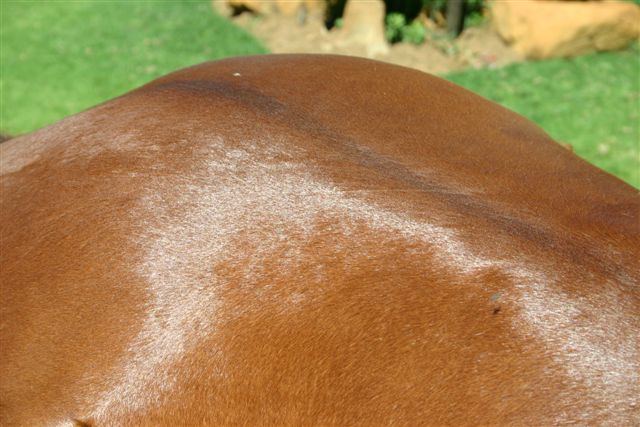 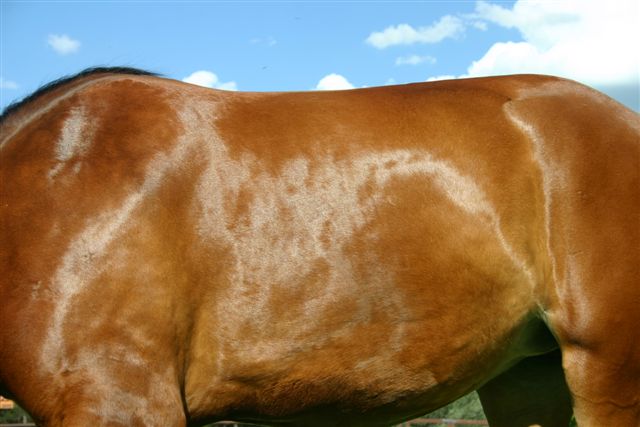 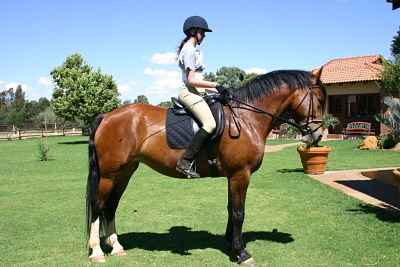
|
| Member: mitma |
Posted on Wednesday, Dec 12, 2007 - 9:30 pm: Lea-Anne,She is just so beautiful and bright... this year she does look more like a blood bay! But her "dorsal" stripe is just that slightly darkened linear area that bay horses often get, it's not the dorsal stripe of horses with the dun dilution gene... Martha |
| Member: christel |
Posted on Thursday, Dec 13, 2007 - 8:19 am: Beautiful horse Lea-Anne- I agree w/ Martha, that is not a true dorsal stripe- I would call it counter shading- many bays have this. |
| Member: hpyhaulr |
Posted on Thursday, Dec 13, 2007 - 10:45 am: Lea Anne,I have to laugh... Your big beautiful Amanda is so fortunate to have your petite and disciplined self on her back. My Tuffy would be stunningly jealous. I am an overfed saddlebag who can only dream of 'sitting a horse' as gracefully as you. In motion, I remind observers of a dead fish flopping around the top of a beautiful middle aged (15) shiny penny. You complete her to the point that noone could notice any stripe forsal or otherwise. I know my Tuffy loves me, but I fear I embarrass her with my 'green' which has not even a passing resemblance to environmental astuteness. Have you ever seen a horse with an apologetic "see what I gotta put up with?" grin on her face???? |
| Member: erika |
Posted on Thursday, Dec 13, 2007 - 11:17 am: Ah... a beautiful summer coat...(sigh). I'm moving to Africa. |
| Member: mientjie |
Posted on Friday, Dec 14, 2007 - 12:24 pm: Thank you everyone!! All the people at the new stables ADORE her and Amanda loves all the attention and stands up proud with a face that says, "Thank you, thank you, I know I'm the Queen of this place!".Cyndy, I know that look all to well, but you'd be suprised at all the looks I've gotten from Amanda... you can almost hear her thoughts.. LOL. Erika, yes she does have a lovely summer coat, but moving to Afrika, you'd have to be prepared for all the extreme heat and rain we've been having this year. Amanda was NOT happy to have a dressage lesson at the hottest time of day. Her face said: Mom, you're crazy to let me work in this heat, it's not good for my health! Here is another photo of her which I think is very cute: 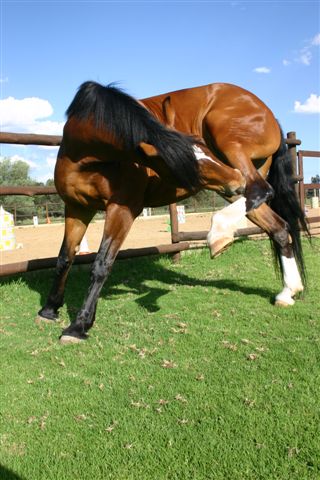
|
| Member: lilo |
Posted on Friday, Dec 14, 2007 - 12:45 pm: She is a gorgeous horse, Lea-Anne. I can tell how proud you are of her.Good luck for the future, Lilo |
is The Horseman's Advisor
Helping Thousands of Equestrians, Farriers, and Veterinarians Every Day
All rights reserved, © 1997 -
